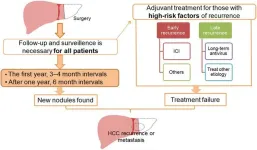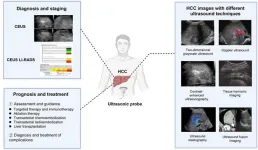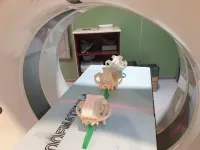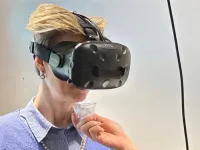Foreign direct investments may fuel tropical deforestation
2024-07-16
Foreign direct investments (FDI) in tropical countries in extractive industries like mining, logging and fossil fuels have a long, environmentally destructive track record in tropical countries. Are FDI in food systems another extractive industry?
Highlights:
Foreign direct investment (FDI) in food systems are a major contributor to deforestation in tropical countries, an advanced machine learning model shows
Laws requiring deforestation-free exports are welcome but likely address only a fraction of forest loss potentially linked to FDI in food systems in domestic markets
Better regulation of FDI in domestic food production is needed to save more forest ...
Timing is everything: Study finds link between bowel movement frequency and overall health
2024-07-16
SEATTLE – Everybody poops, but not every day. New research by the Institute for Systems Biology (ISB) suggests bowel movement frequency is linked to long-term health.
An ISB-led research team examined the clinical, lifestyle, and multi-omic data of more than 1,400 healthy adults. How often people poop, they found, can have a large influence on one’s physiology and health. Their findings will be published in the Cell Reports Medicine on July 16.
Researchers explored data from consenting participants of the consumer wellness company Arivale. The ...
Hormone therapy for breast cancer linked with lower dementia risk
2024-07-16
Hormone modulating therapy (HMT) used for the treatment of breast cancer was associated with a 7% lower risk of developing Alzheimer’s disease and related dementias later in life, according to a new study published today in JAMA Network Open.
The study, which is one of the largest of its kind, found that although HMT was linked with protection against the development of dementia overall, the association decreased with age and varied by race.
“Our findings emphasize the importance of being cognizant of individual patient factors when we prescribe medications or develop treatment plans for breast cancer,” said senior author Francesmary Modugno, Ph.D. M.P.H., ...
Alzheimer disease and related dementia following hormone-modulating therapy in patients with breast cancer
2024-07-16
About The Study: In this retrospective cohort study, hormone therapy was associated with protection against Alzheimer disease and related dementias in women age 65 or older with newly diagnosed breast cancer; the decrease in risk was relatively greater for Black women and women under age 75, while the protective effect of hormone-modulating therapy (HMT) diminished with age and varied by race in women. When deciding to use HMT for breast cancer in women age 65 years or more, clinicians should consider age, self-identified race, and HMT type in treatment decisions.
Corresponding ...
AI tool successfully responds to patient questions in electronic health record
2024-07-16
As part of a nationwide trend, many more of NYU Langone Health’s patients during the pandemic started using electronic health record tools to ask their doctors questions, refill prescriptions, and review test results. Many patients’ digital inquiries arrived via a communications tool called In Basket, which is built into NYU Langone’s electronic health record (EHR) system, EPIC.
While physicians have always dedicated time to managing EHR messages, they saw a more than 30% annual increase in recent years in the number of messages received daily, according an article by ...
New analysis of Cassini data yields insights into Titan’s seas
2024-07-16
UNDER EMBARGO UNTIL JULY 16, 2024, AT 11:00 AM ET
ITHACA, N.Y. – A new study of radar experiment data from the Cassini-Huygens mission to Saturn has yielded fresh insights related to the makeup and activity of the liquid hydrocarbon seas near the north pole of Titan, the largest of Saturn’s 146 known moons.
The key takeaway: Using data from several bistatic radar experiments, a Cornell University-led research team was able to separately analyze and estimate the composition and roughness of Titan’s sea surfaces, something previous analyses of monostatic radar data were unable to achieve. This will help pave the way for future combined ...
New sleep study aims to understand cognitive decline in women
2024-07-16
LA JOLLA, CA—Alzheimer’s disease, the most common type of dementia, currently affects twice as many women as men, with minority populations predicted to witness the most significant increase in cases in the coming years, according to the Centers for Disease Control and Prevention.
Disturbances in sleep are well-known in dementia but have previously been explained as an outcome of the disease, not the cause. Increasing evidence, however, now implicates sleep disturbances with the development of dementia.
In a bid to better understand the relationship between sleep and cognitive outcomes in women, scientists at the Scripps ...
Turning agricultural trash to treasure
2024-07-16
In California's Northern San Joaquin Valley, agricultural leftovers such as almond shells, fruit peels, and orchard trimmings can potentially be converted into sustainable bioproducts and biofuels – with the right technology. Today, Schmidt Sciences’ Virtual Institute on Feedstocks of the Future awarded new funding to a group investigating how to make better use of the diverse agricultural waste in the region.
The group, “Building the Circular Bioeconomy in the North San Joaquin Valley” or BioCircular Valley, is co-led by the Department of Energy’s Lawrence Berkeley National Laboratory (Berkeley Lab), UC Berkeley, and BEAM Circular, ...
Adjuvant therapy for hepatocellular carcinoma after curative treatment: Several unanswered questions
2024-07-16
Hepatocellular carcinoma (HCC) is one of the most prevalent malignancies globally and is the third leading cause of cancer-related deaths. The primary curative treatments for HCC are liver transplantation, hepatectomy, and local ablation. However, the recurrence rate of HCC following hepatectomy or ablation remains alarmingly high, up to 70%, severely impacting patient prognosis and overall survival (OS). To mitigate postoperative recurrence and improve patient outcomes, various adjuvant therapies have been explored. Despite the efficacy of several adjuvant treatments in reducing recurrence rates and enhancing survival, ...
Palliative care is underutilized in nursing homes
2024-07-16
INDIANAPOLIS – Palliative care, specialized medical care focusing on providing relief from the symptoms -- including pain -- and the stress of serious illness, is underutilized in nursing homes, despite the large number of nursing home residents living with a serious illness such as cancer, dementia, Parkinson’s disease, heart failure or chronic obstructive pulmonary disease.
A qualitative study, published in the Journal of the American Geriatrics Society, analyzes lack of palliative ...
Understanding others: By age three, we can do this with mirror neurons
2024-07-16
Milan, July 15, 2024 – By the age of three, children are capable of understanding others, "mirroring" those they are with to imitate and anticipate their intentions. They are able to do it thanks to the sophisticated neurofunctional architecture that is necessary to understand others' intentions, the mirror neurons, that result already active at this age.
It’s the result of a study published in the prestigious journal PNAS, led by the collaboration between Giacomo Rizzolatti of the University of ...
Oil and natural gas development in Permian is a key source of ozone pollution in Carlsbad Caverns National Park
2024-07-16
EMBARGO: THIS CONTENT IS UNDER EMBARGO UNTIL 9 A.M. U.S. EASTERN STANDARD TIME ON JULY 16. INTERESTED MEDIA MAY RECIVE A PREVIEW COPY OF THE JOURNAL ARTICLE IN ADVANCE OF THAT DATE OR CONDUCT INTERVIEWS, BUT THE INFORMATION MAY NOT BE PUBLISHED, BROADCAST, OR POSTED ONLINE UNTIL AFTER THE RELEASE WINDOW.
New research shows that ozone concentrations at Carlsbad Caverns National Park frequently exceed Environmental Protection Agency health standards, likely due to oil and natural gas development in the Permian Basin and surrounding region.
The work was led through the Department of Atmospheric Science at Colorado State University and is part of ...
E. coli variant may cause antimicrobial resistance in dogs, humans
2024-07-16
ITHACA, N.Y. – Researchers studying antimicrobial-resistant E. coli – the leading cause of human death due to antimicrobial resistance worldwide – have identified a mechanism in dogs that may render multiple antibiotic classes ineffective.
The paper, which will publish July 16 in the journal Applied and Environmental Microbiology at 9:00am EST, opens up new avenues for therapies to treat both animals and humans – and establishes clinical infections in dogs as a surveillance approach for public health.
The research team analyzed more than 1,000 genomes of the resistant ...
Ultrasonography of hepatocellular carcinoma: From diagnosis to prognosis
2024-07-16
Hepatocellular carcinoma (HCC) is a primary malignancy of the liver and one of the leading causes of cancer-related deaths worldwide. Early detection and accurate diagnosis are crucial for effective management and improved survival rates. Ultrasound (US) technology has significantly advanced and plays a pivotal role in the surveillance, diagnosis, and treatment of HCC. This paper delves into various ultrasound techniques and their clinical applications in HCC management.
Two-dimensional gray-scale ultrasound is a fundamental imaging technique for HCC surveillance. ...
Partisan politics and perceptions of immorality
2024-07-16
Democrats and Republicans overestimate the percentage of people in the opposing party who approve of widely agreed-upon moral wrongs, such as theft or animal abuse, according to a study. Today, Americans hate their opposing political party more than they love their own party, and political animosity and dehumanization of opposing party members have been on the rise for decades. Curtis Puryear and colleagues looked for a “basic morality bias” in social media posts from 5,806 political partisans by searching for words that referencd ...
Should AI be used in psychological research?
2024-07-16
Mohammad Atari and colleagues explore the promise and peril of using large language models (LLMs) in psychological research, beginning by urging researchers to also ask themselves whether and why they should use LLMs—not just how they should use them. The authors caution against using LLMs as a replacement for human participants, noting that LLMs cannot capture the substantial cross-cultural variation in cognition and moral judgement known to exist. Most LLMs have been trained on data primarily from WEIRD (Western, Educated, Industrialized, Rich, Democratic) sources, disproportionately in English. Additionally, although ...
AI makes human-like reasoning mistakes
2024-07-16
Large language models (LMs) can complete abstract reasoning tasks, but they are susceptible to many of the same types of mistakes made by humans. Andrew Lampinen, Ishita Dasgupta, and colleagues tested state-of-the-art LMs and humans on three kinds of reasoning tasks: natural language inference, judging the logical validity of syllogisms, and the Wason selection task. The authors found the LMs to be prone to similar content effects as humans. Both humans and LMs are more likely to mistakenly label an invalid argument as valid when the semantic content is sensical and believable. LMs are also just as bad as humans at the Wason selection task, in which the participant ...
Waterpower scarcity and coal use during the Industrial Revolution
2024-07-16
A study combining history, economics, and fluvial geomorphology examines the causes of the adoption of coal power during the Industrial Revolution in Great Britain. At the beginning of the mechanization of the textile industry in Britain, most machines were powered with waterpower. Eventually waterpower was replaced by using coal to make steam power and the causes of this shift have long been debated. One influential hypothesis has been that waterpower became scarce in the industrial heartland of northwest England during the early 19th century, as all available suitable sites were already fitted with ...
Capturing carbon with energy-efficient sodium carbonate−nanocarbon hybrid material
2024-07-16
Industrial emissions are one of the main sources of climate change-inducing carbon dioxide (CO2). While adopting renewable and clean energy alternatives is one option for mitigating these carbon emissions, carbon capture technology is another solution to control CO2 emissions. In big CO2-emitting industries, such as cement, oil refineries, and thermal power plants, carbon capture technology can be easily applied to remove CO2 emissions directly at the source at a feasible cost and with low energy consumption. Different materials have been explored for CO2 capture in factories, including zeolites, metal−organic frameworks, natural minerals, alkalis, ...
Digital dog and cat skull database
2024-07-16
The ELTE Eötvös Loránd University is home to the skulls of more than 150 dog breeds and other animals. To make this unique collection accessible to all, researchers digitised the skulls of 431 dogs, cats and wild relatives. The database can be used for educational and research purposes.
Tibor Csörgő, a researcher at ELTE, has been collecting animal skulls for decades to teach anatomy to biologists. The shape of the skull varies considerably between species and breeds, especially in dogs, where, for example, greyhounds have long skulls and the now popular French bulldogs have rounded skulls.
A skull biobank ...
Breaking through silicon
2024-07-16
Overcoming Historical Barriers
Silicon, the cornerstone of modern electronics, photovoltaics, and photonics, has traditionally been limited to surface-level nanofabrication due to the challenges posed by existing lithographic techniques. Available methods either fail to penetrate the wafer surface without causing alterations or are limited by the micron-scale resolution of laser lithography within Si. In the spirit of Richard Feynman's famous dictum, 'There's plenty of room at the bottom', ...
A new study finds that early detection of miRNAs in maternal blood may offer the potential for predicting preeclampsia
2024-07-16
Preeclampsia (PE) is a significant contributor to the increase in maternal morbidity and mortality worldwide, with particularly alarming numbers in the United States, where it affects about 2–8% of pregnancies, resulting in premature birth with associated morbidities for their infants as well. A new study by researchers at UCLA Health finds that early detection of specific microRNAs (miRNAs) packaged in vesicles may offer the opportunity to predict preeclampsia in pregnant people before clinical symptoms manifest.
The study, led by Dr. Sherin U. Devaskar, MD, executive chair of the Department of Pediatrics ...
Recycled micro-sized silicon anodes from photovoltaic waste improve lithium-ion battery performance
2024-07-16
Researchers from the Qingdao Institute of Bioenergy and Bioprocess Technology (QIBEBT) of the Chinese Academy of Sciences have developed low-cost micro-sized silicon anodes from recycled photovoltaic waste using a novel electrolyte design.
Their pioneering work, published in Nature Sustainability on July 16, offers a path to more sustainable, low-cost, and high-energy-density batteries that could transform energy storage systems for electric vehicles and renewable energy applications.
Silicon anodes are favored for their ability to substantially increase the energy density of lithium-ion batteries compared to traditional graphite anodes but are hindered by significant volume ...
Current international poverty line a ‘misleading shortcut method’, say experts
2024-07-16
Billions of dollars in foreign aid could be spent more effectively if international poverty statistics were more accurate, according to new research led by King's College London.
Dr Michail Moatsos, a research fellow in the Department of International Development, says current methods for calculating the international poverty line lead to a skewed picture of how poverty is distributed across the world – and this is hampering attempts to eradicate it.
“Currently, international donors cannot prioritise their funds based on the best possible information and therefore funnel those funds to those most in need around the world. A $2.15 per day poverty line affords very different ...
Food aroma study may help explain why meals taste bad in space
2024-07-16
Scientists from RMIT University have led a world-first study on common food aromas that may help explain why astronauts report that meals taste bland in space and struggle to eat their normal nutritional intake.
This research, which is published in the International Journal of Food Science and Technology, has broader implications for improving the diets of isolated people, including nursing home residents, by personalising aromas to enhance the flavour of their food.
Previous research has shown that aroma plays a big role in the flavour of food.
The team in this study tested how people perceived vanilla and almond extracts and lemon essential oil changed from normal environments on ...
[1] ... [917]
[918]
[919]
[920]
[921]
[922]
[923]
[924]
925
[926]
[927]
[928]
[929]
[930]
[931]
[932]
[933]
... [8692]
Press-News.org - Free Press Release Distribution service.









